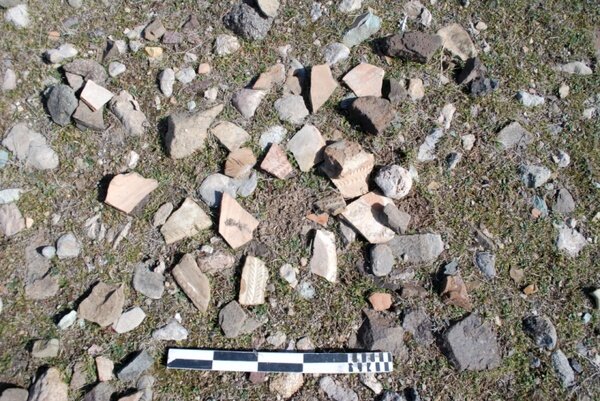Qazvin’s Feyzabad holds historical values: archaeologist

TEHRAN – An Iranian archaeologist has suggested Feyzabad site of Qazvin holds historical values after her team caved some trenches across the property situated in Abyek county of Qazvin province.
Nozar Heydari and his team conducted an archaeological survey to determine the boundaries of the ancient site after it was reported that a fish pond was under construction within the property.
“After several rounds of research and field inspections, finally 26 trenches were drilled on the north and northwest fronts of the site as well as on all four sides of the pool construction area,” the archaeologist explained.
“The locations of trenches, most of which has a depth of 120 cm, were selected at a maximum distance of three meters from each other.”
The surface of the site, which has been the subject of numerous unauthorized excavations in the past, shows that the site enjoys historical values, he said.
So far, a number of earthenware bearing geometrical motifs and sole glazed pottery estimated to date from the (early) Islamic Era have been discovered inside the site, the archaeologist noted.
Qazvin sits in a wide, fertile plain at the southern foot of the Alborz mountain range. Originally called Shad Shahpur, it was founded by the Sasanian king Shapur I about 250 CE. It flourished in early Muslim times (7th century), and was surrounded by strong fortifications by Harun al-Rashid. Genghis Khan laid waste to the city, but it revived under the Safavids when Shah Tahmasp I (ruled 1524–1576) moved the capital from Tabriz to Qazvin.
The city of Qazvin lost its eminence once again when Shah Abbas I (the Great; ruled 1588–1629) transferred the government to Isfahan in 1598. Nader Shah assumed the crown in Qazvin shortly after his return from invading India in 1739 and before returning to Mashhad, the capital of Iran.
Agha Mohammad Khan of the Qajar dynasty reestablished Qazvin about 1796 as a major base for foreign trade with the Caspian Sea, Persian Gulf, and Asia Minor.
Interference by Russia and Britain in the internal politics of Iran in the 19th century and the autocratic rule of the country resulted in unrest and the growth of a nationalist movement. The city fell to a nationalist force from Rasht in 1909. The British established a military headquarters in Qazvin in the 1920s.
For most travelers, Qazvin is primarily the staging point for excursions to the famous Castles of the Assassins and trekking in the sensational Alamut Valley.
AFM
Leave a Comment